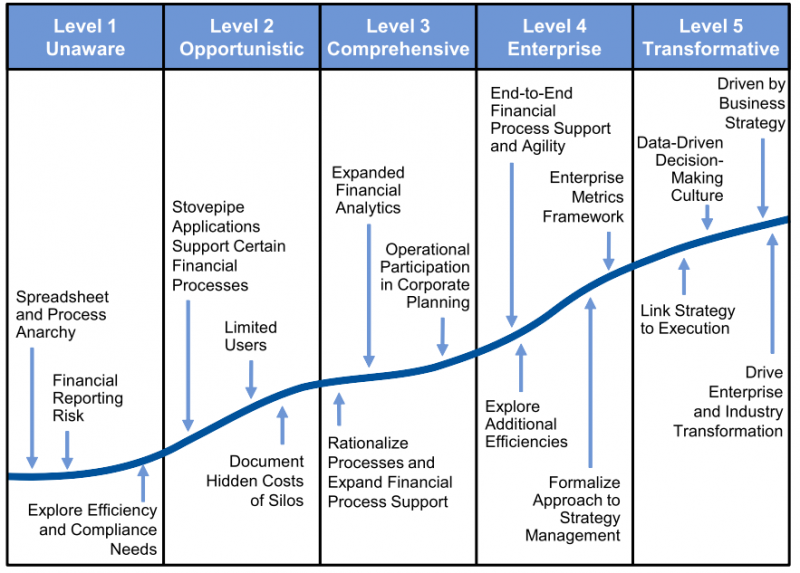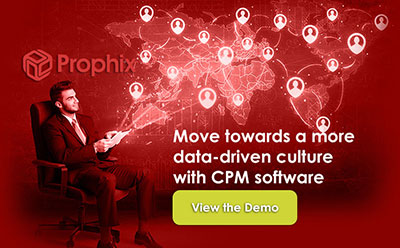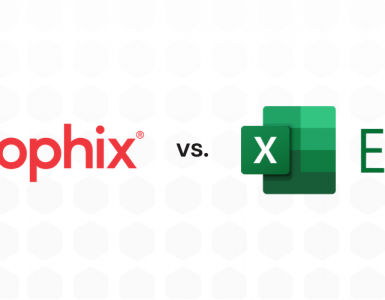Working in finance, I spent too many evenings and weekends working on traditional finance functions: aggregating, checking and fixing historic data, with little time for proper analysis. It was frustrating as I could see where the real business benefits were in where I spent my time and I wanted to improve – to build a modern finance function that went beyond the routine grind and really added value.
A familiar story I am sure, but how does a finance manager start this journey? I’d like to share Gartner’s Corporate Performance Management (CPM) model, plus some personal insights, which could help improve your finance department.
Get your Office of Finance processes into the 21st Century. Watch our free CPM demo here.
Insight #1: To improve your finance department, use a framework to guide you. Gartner’s Corporate Performance Management model is a great place to start.
CPM according to Gartner means translating strategically focused information into operational plans and reporting on the aggregated results: in other words, what your finance department typically does, but tightly linked to strategy and operations, and executed better. The framework is below.

The organisation’s objective is to get from Level 1: Unaware, where the finance department has multiple silos of information (usually in Excel), up to Level 5: Transformative, where information is easy to generate, easy to find, and crucially is linked to business strategy and decision making.
From my experience consulting with over 100 finance functions across the UK, Europe, and the Middle East, most finance functions are somewhere between Level 1 and Level 2. They use mainly Excel, with maybe some applications for analytics, and they spend a lot of time getting information into these silos and reconciling it. There is definitely a better way…
The first win is to move to Level 3: Comprehensive, where your financial system moves beyond the pure finance numbers to include analytics and operational participation. This allows your finance system to add value to the rest of the business.
In my view the key step here is “smart compliance” – automating and controlling your processes so you get the right results without effort. Putting it simply, if you’re in Excel and want information from the business, you often end up collecting it yourself. If you’re automated, you can get information from your sales and Ops depts. without them breaking your model.
Insight #2: A traditional Excel-based finance function can’t be fully integrated into the business – there’s too much to go wrong.
When you get to Level 4: Enterprise you are in complete control of your processes and systems (i.e. you have a good process for setting up processes). This allows the business to adapt quickly to change; you also use consistent metrics throughout your organisation.
If I had one word to sum up this stage it is “consistency”: consistent metrics, a consistent approach to change. To ensure consistency, the finance department has to be the information hub. And for finance to reach out to the other business departments they need dedicated resources – Business Partners.
Indeed, Google Trends shows how interest in “finance business partner” has doubled over the last three years as modern finance departments start to hire people to integrate information through the business:

Insight #3: To get consistent enterprise information, your finance team has to be in the business: You need Business Partners
Level 5: Transformative means the organisation uses key information to link strategy through to operational decisions. It requires multiple sources of information inside and outside the business.
I have come across very few organisations working at this level. The finance department is a key part of achieving this, but only if they change their culture. Historic internal information is easier to find and thus suits accountants who like certainty, but do not directly focus on decisions. Accountants need to ensure they are looking forward for decisions not back.
Insight #4: Decisions require foresight not hindsight. Supporting data-driven decisions requires your finance department to be foresight focused.
Getting to Gartner’s Level 5 is a journey. But if you want a modern finance department that adds real value (and avoids the late nights) it is well worth getting on the right path.
To get underway, start by looking for opportunities to introduce process standardisation and automation in your existing function and then build from there to introduce more innovation and better partnering between finance and other business functions. Do this and you are well on your way to building a modern finance function.
And please stay tuned for more insightful content in our “Building a Modern Finance Function” series. If you have any immediate questions or want to get started on the route to greater CPM maturity today please get in touch.
And if you’re ready to take the next step to CPM maturity – check out our free CPM demo!








